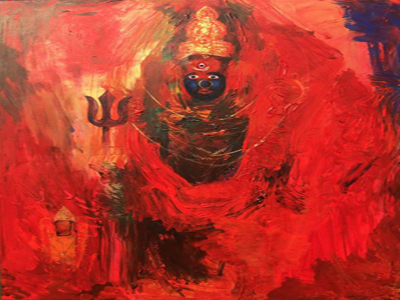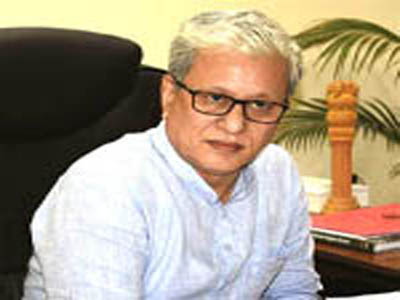THE MISTRESS OF THE THREE WORLDS PART 2


(Edited excerpt from my unpublished book Master of Time)
THE DIVINE MOTHER RETURNS
It happened many generations after Tripur, during the reign of Dhanya Manikya (1490 -1515) the 145th king. One night the king in his dream saw a goddess, who said to him, “You must bring me back to your kingdom, which I left many, many centuries ago. Your general Rai Kachak has met with me, he knows where I am”. This dream, which appeared to Dhanya Manikya, was described elaborately in The Rajmala.
Next morning, the King sent for his general and narrated his dream. Rai Kachak was astounded. He in return informed the King about the incident he had encountered while on his expedition to Chottogram, which was then in the Arakans.
It was the year 1500 AD, just after the festival of Diwali-the festival of lights. The Tripura army led by Rai Kachak ( the famous army general from the Reang Tribe)had set out on their expedition to conquer the Arakans. After passing through Garji, Pilak, Bankul they arrived at Raigarh and made plans to attack Chottogram but later postponed it to March-April.
At that time of the year the King of Arakan would surely then find it very difficult to reinforce his troops. Rai Kachak was an experienced warrior; he divided his army into different sections and dispersed them to various sides; only to regroup later. His modus operandi was very much like the classic theory of guerilla warfare that said:
“When the enemy advances, we retreat,
When the enemy camps, we harass,
When the enemy tires we attack,
And when the enemy retreats we pursue.”
On the other side, the Arakan king gave little importance to the presence of the Tripura army at his border. He could not see through Rai Kachak.s war-plan. He was informed that only a small contingent was present there and was thus complacent. He had enough men to crush a small army.
In the month of March- April 1501 AD Rai Kachak regrouped his men and invaded Arakan with all his might.
When Rai Kachak and his men stopped to take rest for the night. The lightning revealed a small temple perched high on a distant hill. He abandoned the idea of resting and left for the temple with a few of his trusted men; leaving the others in the forest to retire for the night.
The door to the temple was closed but as he approached to open them, they were unlocked from the inside. A young dusky girl, whose face was lit up by the flickering dim oil lamps inside the temple stood, at the doorway. He did not believe his eyes and called for the men, who had come with him. It was only when they confirmed that there was indeed a young girl standing before them that Rai Kachak spoke, “Who are you? What are you doing in the temple at this hour?” The girl replied, “I am the one, whom you came to meet. I have appeared before you in person and have blessed you. Go now and fight your battle. Victory is yours.”
Suddenly, Rai Kachak heard some commotion in the vicinity and at once became alert. He hurriedly took leave of the little girl “There seems to be no time now; but if I am alive I shall come back and offer my prayers to you. Please allow us to leave now.” With these words he left the temple and went back to his men.
On that very night Rai Kachack launched a full scale attack on the Arakan army in an utterly unconventional way; routing the lightly armed Arakan army that was unprepared. The archers of the Tripura force rained arrows on the enemy while the others moved in with spears and lightweight swords. A chaotic fight ensued. Four Arakan commanders lay dead and some were taken as prisoners.
The reinforcement for the Arakan army had arrived. They were on the other side of the river. Seeing the massacre that had taken place; they had just about enough time to get into their boats and sail off; the other forces galloped and ran for their lives into the forest.
Eventually the resistance put up by the enemy was torn to pieces; the Arakan army was caught unaware. They could in no way face the soldiers of Rai Kachak. Some however managed to escape. The Tripura army was finally victorious and triumphantly cried out “Victory to the goddess of the hills!” This success was achieved at the place called Rasanga in Chottogram; where the temple on the hill stood. Rai Kachak was bestowed with the tittle “Rasanga mardan Narayan” – The Victor of Rasanga.
Next morning, Rai Kachak marched towards the Capital of Arakan. Seeing the strength of the Tripura army the king of Arakan sent a messenger to Rai Kachak. It was with a request for calling off the invasion and declaring truce. Rai Kachak demanded that Rasanga be handed over to Tripura, as a tribute to his king Dhanya Manikya. The king of Arakan accepted these terms and signed a treaty the next day. The prisoners of war from both sides were released. In this way the temple of the goddess on the hill came within the boundaries of Tripura.
Now, nothing could stop Rai Kachak from keeping his word. He remembered the promise he had made to the Mother Goddess, on the night of his victory. He ordered his men to prepare for a grand puja in honor of the goddess. There was much fanfare and celebration in the precincts of the temple. After spending a few days there, Rai Kachak appointed a trusted aide as the administrator of Rasanga and made arrangements to travel back to his capital Ragamati in Tripura.
Dhanya Manikya listened to his general’s account of the incidents that took place in the Arakans, with rapt attention. Rai Kachak also told him of another temple in the Arakans dedicated to the goddess Chotteshwari which was popular with the people. The temple that he had visited was somewhat unknown hence, not many devotees went there. In the sanctum sanctorum of this temple there was an idol of a goddess with four arms. The king was now sure that he had dreamt of the goddess in this temple, which was on a hill at Rasanga. After Rai Kachak completed his account, he knew that it was with the blessing of this goddess that the war had been won by Tripura.
He ordered Rai Kachak to bring the goddess to Rangamati; his capital. He explained that in his dream the divine mother had instructed that she must be brought into the kingdom in one day and wherever night fell that would be the place for her temple to be constructed. Early next morning, Rai Kachak along with the Chantai (Royal Priest) and soldiers set out for the temple. The king’s personal elephant bedecked with ornaments was taken along to bring the divine mother to Tripura.
Once they reached the temple, Rai Kachak bowed before the goddess and sought her blessings and her permission to take her to the capital of Tripura. He also informed the king of the Arakans of his mission.
In Rangamati (the old name of now Udaipur)there was a lot of commotion; Dhanya Manikya was getting impatient to see the goddess. His queens were all lined up to welcome the divine mother. Pundits were called in to decide an appropriate place to install the goddess, who was on her way to the capital.
The procession led by the elephant carrying the goddess reached Chandrapur a few kilometers from Rangamati. The sun had set and the elephant refused to move any further. It stood stubbornly on a small hillock, which resembled the back of a tortoise. In spite of all his efforts Rai Kachak was unable to take her to the capital, as per his King’s instructions. The will of the divine mother was always greater than that of any king. Dhanya Manikya knew that it was the wish of the goddess to be installed there. He had no option but to obey her command.
The king was however faced with a dilemma. Earlier, he had constructed a Vishnu temple at this site. How could he now install the divine mother within this temple? It was unprecedented in Hindu tradition to house both Vishnu and Devi (mother goddess) under the same roof.
He conferred with his pundits but they were unanimous in voicing their dissent of housing the two deities under the same roof. Dhanya Manikya was in a fix. He knew not what course of action should be followed. It was then he heard a voice, “Do not fear, the night will pass at this holy place that I have chosen. There is no difference between Vishnu and the Divine Mother. The creator is also a mother. Do not hesitate to install me within this temple”. In obedience to the goddess; Dhanya Manikya installed this idol within the Vishnu temple at Chandrapur. This was perhaps rare in a temple where both Vishnu and Devi are worshipped together. Even today the small “Shaligram”; the symbol of Vishnu sits on a brass throne in front of the goddess. The Goddess brought in from Rasanga in Chottogram was called Tripureshwari and Tripura Sundari by the people of this land.
Once the Mistress of the Three Worlds returned, Tripura flourished like never before. The kingdom grew into an empire and brought within its fold places, which were both strategic and economically important. To the west it stretched as far as it could; the entire Meghna Valley was annexed. It consisted of places that were now in Myanmar, Bangladesh and Assam. Tripura extended its boundaries on all sides; east, west, north and south. Important places like Arakan, Chottogram, Khandal, Sylhet, Comilla, Langla, the Lushai Hills and many more came within its realm.
Dhanya Manikya along with two of his most capable generals from the Reang Tribe; Rai Kachak and Rai Kasam were victorious in most of their military expeditions, undertaken to expand the boundaries of their kingdom. They were also successful in safeguarding the territorial integrity of their empire against several invasions by Allauddin Hussain Shah (1493 – 1519 AD), the ruler of Gour (Bengal). They however, believed that all this was possible only by the blessing and inspiration of Tripura Sundari, the divine mother.
From 1501AD Tripura Sundari has stood at the same place through the reigns of many kings who have come and gone. Now she stands as an observer to the various changes that had been ushered in with time and democracy. Some of which are painful and some are good.
Tripureshswari, the mistress of the three worlds remained a symbol of her people’s unwavering trust in her and of their respect for the past. Her people still prayed to her through a Sanskrit shloka ( which was given to me by the raj pundit at the time of my sacred thread ceremony which I still wear just to remember this). Sanskrit is indeed the language of the gods. Therefore to try and translate a shloka to English was a challenge.
“Vivadeh, Vishadeh Pramoday Pravashay,
Jaley, chabhanaley, parvate, shatru maddhey,
Aranney, Sharanney sadah mangprapahi,
Gatistwang, gatistwang twammeka Bhabani”
In conflict and in sorrow, in joy and in distant lands,
In water or in burning fire, on hills or amongst enemies,
In the forest and at home, lead us on forever,
Oh Divine Mother, you are our path and our destination”
(In our Dharmic Tradition Ma Kali is the symbolic representation of Kaal ( feminine gender kaali) Time. As mother she creates and also destroys. Creation and destruction - one cannot happen without the other. She (Time/ Kaali) stands on SHIVA -the ultimate Truth ( Satyam Shivam Sundaram )
“Happy Diwali and Kali Puja May the Mistress of the three worlds Tripura Sundari enrich our lives with her blessings